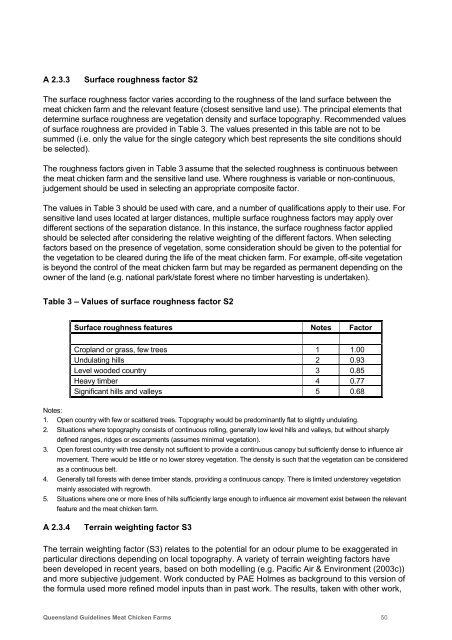Queensland Guidelines: Meat Chicken Farms - Department of ...
Queensland Guidelines: Meat Chicken Farms - Department of ...
Queensland Guidelines: Meat Chicken Farms - Department of ...
You also want an ePaper? Increase the reach of your titles
YUMPU automatically turns print PDFs into web optimized ePapers that Google loves.
A 2.3.3<br />
Surface roughness factor S2<br />
The surface roughness factor varies according to the roughness <strong>of</strong> the land surface between the<br />
meat chicken farm and the relevant feature (closest sensitive land use). The principal elements that<br />
determine surface roughness are vegetation density and surface topography. Recommended values<br />
<strong>of</strong> surface roughness are provided in Table 3. The values presented in this table are not to be<br />
summed (i.e. only the value for the single category which best represents the site conditions should<br />
be selected).<br />
The roughness factors given in Table 3 assume that the selected roughness is continuous between<br />
the meat chicken farm and the sensitive land use. Where roughness is variable or non-continuous,<br />
judgement should be used in selecting an appropriate composite factor.<br />
The values in Table 3 should be used with care, and a number <strong>of</strong> qualifications apply to their use. For<br />
sensitive land uses located at larger distances, multiple surface roughness factors may apply over<br />
different sections <strong>of</strong> the separation distance. In this instance, the surface roughness factor applied<br />
should be selected after considering the relative weighting <strong>of</strong> the different factors. When selecting<br />
factors based on the presence <strong>of</strong> vegetation, some consideration should be given to the potential for<br />
the vegetation to be cleared during the life <strong>of</strong> the meat chicken farm. For example, <strong>of</strong>f-site vegetation<br />
is beyond the control <strong>of</strong> the meat chicken farm but may be regarded as permanent depending on the<br />
owner <strong>of</strong> the land (e.g. national park/state forest where no timber harvesting is undertaken).<br />
Table 3 – Values <strong>of</strong> surface roughness factor S2<br />
Surface roughness features Notes Factor<br />
Cropland or grass, few trees 1 1.00<br />
Undulating hills 2 0.93<br />
Level wooded country 3 0.85<br />
Heavy timber 4 0.77<br />
Significant hills and valleys 5 0.68<br />
Notes:<br />
1. Open country with few or scattered trees. Topography would be predominantly flat to slightly undulating.<br />
2. Situations where topography consists <strong>of</strong> continuous rolling, generally low level hills and valleys, but without sharply<br />
defined ranges, ridges or escarpments (assumes minimal vegetation).<br />
3. Open forest country with tree density not sufficient to provide a continuous canopy but sufficiently dense to influence air<br />
movement. There would be little or no lower storey vegetation. The density is such that the vegetation can be considered<br />
as a continuous belt.<br />
4. Generally tall forests with dense timber stands, providing a continuous canopy. There is limited understorey vegetation<br />
mainly associated with regrowth.<br />
5. Situations where one or more lines <strong>of</strong> hills sufficiently large enough to influence air movement exist between the relevant<br />
feature and the meat chicken farm.<br />
A 2.3.4<br />
Terrain weighting factor S3<br />
The terrain weighting factor (S3) relates to the potential for an odour plume to be exaggerated in<br />
particular directions depending on local topography. A variety <strong>of</strong> terrain weighting factors have<br />
been developed in recent years, based on both modelling (e.g. Pacific Air & Environment (2003c))<br />
and more subjective judgement. Work conducted by PAE Holmes as background to this version <strong>of</strong><br />
the formula used more refined model inputs than in past work. The results, taken with other work,<br />
<strong>Queensland</strong> <strong>Guidelines</strong> <strong>Meat</strong> <strong>Chicken</strong> <strong>Farms</strong> 50
















